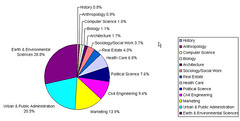Here is a breakdown of the 474 students who came into the GIS Lab needing help this Fall 2005 semester
click to enlarge

As you can see, we do not have a geography department at the university, so approximately 1/2 of folks needing spatial assistance are either in Earth & Environmental Sciences or Urban & Public Administration. This makes sense as these are the only two departments that confer degrees and certifications in GIS/RS.
It is the other 1/2 that interest me the most. With only a handful of actual credit courses in their major departments, these students are often going out of their way to include maps and spatial analysis in their projects. An ambitious professor who pushes him/herself and their students is always a great motivator.
There are three things that really stand out in my mind from this semester.
- First are all of the marketing students who are taking it on themselves to use spatial datasets and analysis. Once one student found out the great marketing/consumer datasets that we have, these marketing students never stopped coming. Combined, the marketing and real estate students took up almost 18% of my student assistance hours this semester. Let's hear it for the ambitious business students.
(Especially as I get ready to teach the Advanced Real Estate Market Analysis course next semester.) - Second of all was that super-ambitious anthropology student needing to perform a batch viewshed analysis of stone circles in Ireland. This was a lot of fun to assist the student with and it gave GIS a lot of exposure in the anthropology department. The work I did with this student lead to all of the geoprocessing demonstrations and applications I developed this semester.
- Third of all is that the variety of students and question types continue to increase each semester. Political Science students seeking looking to map voting potential. History students seeking to map population and boundary shifts. Add in there epidemiological studies, community assessments for need-based grants, spatial based property valuations...the list really goes on and on.
The Frost and Sullivan report, announced by All Points Blog, project increases in the use and development of location based services. There is no doubt that these students will be the consumers and developers.

No comments:
Post a Comment